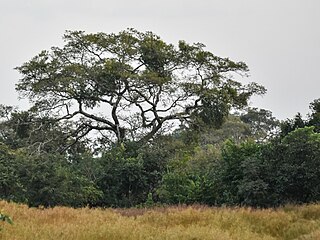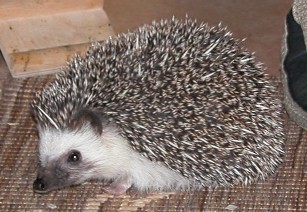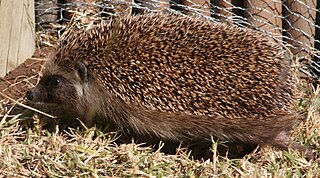
A hedgehog is a spiny mammal of the subfamily Erinaceinae, in the eulipotyphlan family Erinaceidae. There are seventeen species of hedgehog in five genera found throughout parts of Europe, Asia, and Africa, and in New Zealand by introduction. There are no hedgehogs native to Australia and no living species native to the Americas. However, the extinct genus Amphechinus was once present in North America.

A tenrec is a mammal belonging to any species within the afrotherian family Tenrecidae, which is endemic to Madagascar. Tenrecs are a very diverse group; as a result of convergent evolution, some resemble hedgehogs, shrews, opossums, rats, and mice. They occupy aquatic, arboreal, terrestrial, and fossorial environments. Some of these species, including the greater hedgehog tenrec, can be found in the Madagascar dry deciduous forests. However, the speciation rate in this group has been higher in humid forests.

Koreans are an East Asian ethnic group and nation native to Korea. The majority of Koreans live in the two Korean nation states of North and South Korea, which are collectively referred to as Korea. As of 2021, an estimated 7.3 million ethnic Koreans resided outside of Korea. Koreans are also an officially recognised ethnic minority in other several Continental and East Asian countries, including China, Japan, Kazakhstan, Russia, and Uzbekistan. Outside of Continental and East Asia, sizeable Korean communities have formed in Germany, the United Kingdom, France, the United States, Canada, Australia, and New Zealand.

Erinaceidae is a family in the order Eulipotyphla, consisting of the hedgehogs and moonrats. Until recently, it was assigned to the order Erinaceomorpha, which has been subsumed with the paraphyletic Soricomorpha into Eulipotyphla. Eulipotyphla has been shown to be monophyletic; Soricomorpha is paraphyletic because both Soricidae and Talpidae share a more recent common ancestor with Erinaceidae than with solenodons.

The National Park of Upper Niger is a national park in Guinea that was gazetted in January 1997 with a core area of 554 km2 (214 sq mi). The park protects important tracts of forest and savannah, and is considered a conservation priority for West Africa as a whole.
The domesticated hedgehog kept as a pet is typically the African pygmy hedgehog. Other species kept as pets include the long-eared hedgehog and the Indian long-eared hedgehog.
Wobbly hedgehog syndrome (WHS) is a progressive, degenerative, neurological disease of the African pygmy hedgehog. The cause is believed to be genetic. Nearly 10 percent of pet African pygmy hedgehogs are affected, due to their limited bloodlines.

The four-toed hedgehog, also known as the African pygmy hedgehog, is a species of hedgehog found throughout much of central and eastern Africa.

The white-eared opossum, known as the timbu and cassaco in northeast Brazil, saruê and sariguê in Bahia, micurê and mucura in northern Brazil and comadreja overa in Argentina, is an opossum species found in Argentina, Bolivia, Brazil, Paraguay, and Uruguay. It is a terrestrial and, sometimes, arboreal animal, and a habitat generalist, living in a wide range of different habitats.

The North African hedgehog or Algerian hedgehog, is a mammal species in the family Erinaceidae native to Algeria, Libya, Malta, Morocco, Spain, and Tunisia. Little is known about this hedgehog, even though the most common breed of domesticated hedgehogs is a result of crossing a four-toed hedgehog with a North African hedgehog. Because this species of hedgehog is native to Africa, it has been suggested that it was introduced by humans to the other countries where it is now found, including Spain and the Canary Islands. Of the four African hedgehog species, the North African hedgehog is the only one of these hedgehogs that occurs outside Africa. Because the North African hedgehog has such a wide habitat range and has a seemingly stable population, both in the wild and in the domesticated capacity, it does not appear to currently be at risk.

Atelerix is a genus of hedgehog in the family Erinaceidae. It contains four species, all native to Africa.

The Southern African hedgehog is a species of mammal in the family Erinaceidae. It is found in Angola, Botswana, Lesotho, Namibia, South Africa, Tanzania and Zimbabwe.

The Somali hedgehog is a species of mammal in the family Erinaceidae. It is endemic to Somalia and Somaliland. The Somali hedgehog is nocturnal.

Hydnum is a genus of fungi in the family Hydnaceae. They are notable for their unusual spore-bearing structures of teeth rather than gills. The best known are the edible species Hydnum repandum and H. rufescens. There are no known toxic varieties of Hydnum. Widely regarded as important maintainers of forest ecosystems, the Hydnum genus is known to have ectomycorrhizal relationships with multiple plant families. Hydnum has many brittle, white teeth from which the spores drop. Some species have teeth which hang from ascending branches, while other species have teeth which project downwards from the undersurfaces of dead wood. Most Hydnum species are safe to eat, and contain many fatty acids and antioxidants.
A superficial acral fibromyxoma is a type of myxoma and is a rare cutaneous condition characterized by a mesenchymal neoplasm that typically occurs on the digits of middle-aged adults.

Physaloptera is a genus of parasitic nematodes in the family Physalopteridae.
The International Hedgehog Registry is a registry for the hedgehog. It records the pedigrees of animals that have been registered, and makes the information available to scientists.
The Bhanja virus is a tick-borne virus first discovered in a tick taken from a paralyzed goat in Bhanjanagar, India in 1954. Bhanja virus in humans was first documented in 1974 when Charles Calisher was working with the virus in a lab and contracted it himself. His experience with the virus was mild and included symptoms of mild aching in muscles and joints, moderate headache, slight photophobia. The Bhanja virus is a member of the Bhanja virus serocomplex and is a member of the Bunyavirales order.











